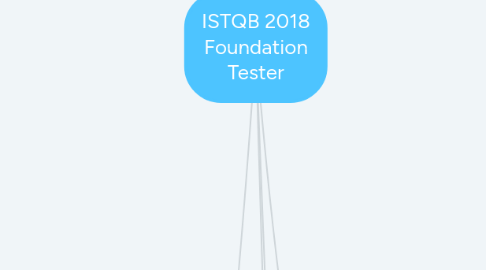
1. 3. Static Testing
1.1. Work Products
1.1.1. Specifications
1.1.2. Epics, User Stories, Acceptance Criteria
1.1.3. Arch. & Design Specs
1.1.4. Code
1.1.5. Testware
1.1.6. User Guides
1.1.7. Web Pages
1.1.8. Contracts, Project Plans, Schedules and Budgets
1.1.9. Models (EG Activity Diagrams)
1.2. Reviews
1.2.1. Process
1.2.1.1. Planning
1.2.1.2. Initiate Review
1.2.1.3. Individual Review
1.2.1.4. Issue Comms & Analysis
1.2.1.5. Formal Review
1.2.1.6. Fixing & Reporting
1.2.2. Roles
1.2.2.1. Author
1.2.2.2. Management
1.2.2.3. Facilitator / Moderator
1.2.2.4. Review Leader
1.2.2.5. Reviewers
1.2.2.6. Scribe
1.2.3. Types
1.2.3.1. Informal
1.2.3.2. Walkthrough
1.2.3.3. Technical
1.2.3.4. Inspection
1.2.4. Techniques
1.2.4.1. Ad Hoc
1.2.4.2. Checklist
1.2.4.3. Scenarios / Dry Runs
1.2.4.4. Role Based
1.2.4.5. Perspective Based
2. 4. Test Techniques
2.1. Black Box
2.1.1. Equivalence Partitioning
2.1.2. Boundary Value Analysis
2.1.3. Decision Table Testing
2.1.4. State Transition Testing
2.1.5. Use Case Testing
2.2. White Box
2.2.1. Statement Testing & Coverage
2.2.2. Decision Testing & Coverage
2.2.3. Statement Coverage
2.2.4. Branch Coverage
2.2.5. Path Coverage
2.3. Experience Based
2.3.1. Error Guessing
2.3.2. Exploratory
2.3.3. Checklist
3. 5. Test Management
3.1. Organisation
3.2. Planning / Estimating
3.2.1. Test Plan
3.2.1.1. Scope
3.2.1.2. Approach
3.2.1.2.1. Analytical
3.2.1.2.2. Model Based
3.2.1.2.3. Methodical
3.2.1.2.4. Standards Compliant
3.2.1.2.5. Directed
3.2.1.2.6. Regression Averse
3.2.1.2.7. Reactive
3.2.1.3. Integrating to SDL
3.2.1.4. Decision Making
3.2.1.4.1. What to Test
3.2.1.4.2. Personnel
3.2.1.4.3. How to Test
3.2.1.5. Scheduling
3.2.1.6. Metrics
3.2.1.7. Budgeting
3.2.1.8. Documentation Detail Definition
3.2.2. Test Execution Scedule
3.2.3. Entry & Exit Criteria
3.2.3.1. Exit
3.2.3.1.1. Coverage of Code Sufficient
3.2.3.1.2. Scheduled / Planned tests Executed
3.2.3.1.3. Estimates of Remaining Defects (Defect Density)
3.2.3.1.4. Quality Metrics Sufficiently Good
3.2.3.1.5. (Budget Expended)
3.2.3.1.6. (Pressure to Bring to Market)
3.2.3.2. Entry
3.2.3.2.1. Availability of testable requirements
3.2.3.2.2. Availability of test Items that have met previous exit criteria
3.2.3.2.3. Availability of test Environment
3.2.3.2.4. Availability of necessary Test Tools
3.2.3.2.5. Availability of Test Data & Resources
3.2.4. Test Estimation Techniques
3.3. Monitoring / Control
3.3.1. Metrics
3.3.2. Purpose, Contents & Audience for Test Reports
3.4. Configuration Management
3.4.1. IDs for Test Items
3.4.2. IDs for TestWare
3.4.3. IDs for Docs etc
3.5. Risks
3.5.1. Project Issues
3.5.2. Organisational Issues
3.5.3. Political Issues
3.5.4. Technical Issues
3.5.5. Supplier Issues
3.6. Defect Management
4. 7. My Blog: https://gadgeteer.home.blog/
5. 1. Fundamentals
5.1. Types
5.1.1. Errors
5.1.2. Defects
5.1.3. Failures
5.2. 7 Testing Principals
5.2.1. 1. Presence of Defects
5.2.2. 2. Exhaustive Testing Impossible
5.2.3. 3. Early Testing saves Time & Money
5.2.4. 4. Defects Cluster Together
5.2.5. 5. Pesticide Paradox
5.2.6. 6. Context Dependence
5.2.7. 7. Absence of errors is a fallacy
5.3. Activities & Tasks
5.3.1. Planning
5.3.2. Monitoring
5.3.3. Analysis
5.3.4. Design
5.3.5. Implementation
5.3.6. Execution
5.3.7. Completion
6. 2. Software Development Lifecycle
6.1. Models
6.1.1. Sequential
6.1.1.1. Waterfall
6.1.1.2. "V" Model
6.1.2. Iterative
6.1.2.1. Rational
6.1.2.2. Scrum
6.1.2.3. Kanban
6.1.2.4. Spiral
6.2. Levels
6.2.1. Component
6.2.1.1. Detailed Design
6.2.1.2. Code
6.2.1.3. Data Model
6.2.1.4. Component Specs
6.2.2. Integration
6.2.2.1. Design Docs
6.2.2.2. Sequence Diagrams
6.2.2.3. Interface Specs
6.2.2.4. Use Case
6.2.2.5. Architecture
6.2.2.6. Workflows
6.2.2.7. External Interface Definitions
6.2.3. System
6.2.3.1. Requirements
6.2.3.2. Risk Analysis Reports
6.2.3.3. Use Case
6.2.3.3.1. Actor Represents a User
6.2.3.3.2. Describes interactions between actors
6.2.3.3.3. Test Cases can be used on use case scenarios
6.2.3.3.4. Often identifies gaps not found when testing individual components
6.2.3.4. Epics and User Stories
6.2.3.5. Models of Behavior
6.2.3.6. State Diagrams
6.2.3.7. User Manuals
6.2.4. Acceptance
6.2.4.1. User
6.2.4.2. Operational
6.2.4.3. Contractual / Regulatory
6.2.4.4. Alpha / Beta
6.3. Types
6.3.1. Functional
6.3.2. Non Functional
6.3.3. White Box "How"
6.3.4. Change Related
6.4. Maintenance Testing
6.4.1. Triggers
6.4.1.1. Retirement
6.4.1.2. Migrations
6.4.1.3. Modifications
7. 6. Tool Considerations
7.1. Classifications
7.1.1. Managing Testware
7.1.2. Static Testing Tools
7.1.3. Design & Implementation
7.1.4. Test Execution & Logging
7.1.5. Performance measurement & Dynamic Analysis
7.1.6. Special Reqs.
7.1.6.1. Data Quality Assessment
7.1.6.2. Data Conversion & Migration (ETL)
7.1.6.3. Usability Testing
7.1.6.4. Accessibility Testing
7.1.6.5. Localisation Testing
7.1.6.6. Security Testing
7.1.6.7. Portability Testing
7.2. Principals for Selection
7.2.1. Maturity of Organisation
7.2.2. Improving Test Process
7.2.3. Technological Compatibility
7.2.4. Existing tool Compatibility
7.2.5. Clear Requirements with Objective Criteria
7.2.6. Free Trials?
7.2.7. Vendor Quality
7.2.8. Internal Coaching/Mentoring Requirements
7.2.9. Training Needs
7.2.10. Commercial or Open Source?
7.2.11. Cost Benefit Analysis / Concrete Business Case
7.3. Success Factors
7.3.1. Incremental Rollout
7.3.2. Improve existing processes
7.3.3. Training Provision
7.3.4. Guidelines for use
7.3.5. Gaining Feedback from use
7.3.6. Providing Support
7.3.7. Gathering Lessons Learned
